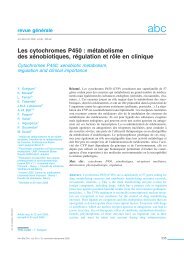Effects and clinical potential of very-low-calorie diets (VLCDs) in ...
Effects and clinical potential of very-low-calorie diets (VLCDs) in ...
Effects and clinical potential of very-low-calorie diets (VLCDs) in ...
Create successful ePaper yourself
Turn your PDF publications into a flip-book with our unique Google optimized e-Paper software.
DIAB-4541; No <strong>of</strong> Pages 84diabetes research <strong>and</strong> <strong>cl<strong>in</strong>ical</strong> practice xxx (2009) xxx–xxxserum creat<strong>in</strong><strong>in</strong>e >130 mmol/L [45], while another studyshowed <strong>in</strong>creased creat<strong>in</strong><strong>in</strong>e clearance <strong>and</strong> reduced prote<strong>in</strong>uria<strong>in</strong> 24 patients with T2D undergo<strong>in</strong>g a VLCD [46]. Prior tocommencement <strong>of</strong> a VLCD <strong>in</strong> the diabetic patient screen<strong>in</strong>g<strong>in</strong>vestigations therefore should <strong>in</strong>clude markers <strong>of</strong> glycaemiccontrol such as glycosylated haemoglob<strong>in</strong> A1c (HbA1c), serumelectrolytes <strong>and</strong> renal function, liver function tests, thyroidfunction, lipid pr<strong>of</strong>ile <strong>and</strong> uric acid level, ur<strong>in</strong>ary album<strong>in</strong>, <strong>and</strong>an electrocardiogram (ECG).5. <strong>VLCDs</strong> effect on glycaemia <strong>in</strong> T2D<strong>Effects</strong> <strong>of</strong> <strong>VLCDs</strong> on plasma glucose levels occur rapidly, withfalls <strong>in</strong> mean glucose levels seen with<strong>in</strong> days <strong>and</strong> reach<strong>in</strong>gnear-nadir after 1–2 weeks [47]. The majority <strong>of</strong> the glucose<strong>low</strong>er<strong>in</strong>geffect seems related to <strong>calorie</strong> restriction, whereasweight loss has an <strong>in</strong>creas<strong>in</strong>g contribution with time viareductions <strong>in</strong> <strong>in</strong>traabdom<strong>in</strong>al (visceral) adipose tissue [48–50].In a 12-week study <strong>of</strong> 14 obese patients with T2DM us<strong>in</strong>g<strong>VLCDs</strong>, marked improvement was seen <strong>in</strong> glycosylated HbA1c[51]. Twelve-month fol<strong>low</strong>-up data <strong>in</strong> n<strong>in</strong>e <strong>in</strong>dividuals showeda rise <strong>in</strong> HbA1c but this rema<strong>in</strong>ed be<strong>low</strong> basel<strong>in</strong>e (8.8% versus8.1%, p < 0.05) [52]. Another study <strong>in</strong> 36 obese subjects withT2D compared the addition <strong>of</strong> a VLCD or LCD to a 20-weekbehavioural program [53]. At 20 weeks significantly moreweight was lost <strong>in</strong> the VLCD group (18.6 kg versus 10.1 kg),however this was not susta<strong>in</strong>ed over the next 12 months(8.6 kg versus 6.8 kg). Significant differences were ma<strong>in</strong>ta<strong>in</strong>ed,however, with respect to fast<strong>in</strong>g glucose levels (9.17 mmol/Lversus 11.78 mmol/L) <strong>and</strong> HbA1c while antidiabetic medicationuse at 72 weeks was similar between groups. However, asubsequent study look<strong>in</strong>g at <strong>in</strong>termittent use <strong>of</strong> VLCD <strong>in</strong> 93people with T2DM led to only modestly better weight loss at 1year (14.2 kg versus 10.5 kg) <strong>and</strong> no improvement <strong>in</strong> HbA1c,glucose or <strong>in</strong>sul<strong>in</strong> levels compared to yearlong LCD [54]. A5-year study <strong>of</strong> 15 obese patients with T2D (two with recentonset) showed no significant differences by study’s end <strong>in</strong>fructosam<strong>in</strong>e or fast<strong>in</strong>g glucose levels, although one patientsusta<strong>in</strong>ed >10 kg weight loss <strong>and</strong> rema<strong>in</strong>ed <strong>in</strong> remission fromdiabetes at 5 years [55].Beta-cell function <strong>in</strong> people with T2D undergo<strong>in</strong>g VLCDtreatment improves but rema<strong>in</strong>s significantly impaired [56].Both people without diabetes <strong>and</strong> people with T2D show a fall<strong>in</strong> fast<strong>in</strong>g plasma <strong>in</strong>sul<strong>in</strong>/c-peptide levels [57]. In T2D patientsno return <strong>of</strong> the first-phase <strong>in</strong>sul<strong>in</strong> response is seen. However,there are improvements <strong>in</strong> dynamic <strong>in</strong>sul<strong>in</strong> secretion <strong>and</strong>overall <strong>in</strong>sul<strong>in</strong> production, modulation <strong>of</strong> pulsatility <strong>and</strong>improved synchrony [58]. High-ketogenic <strong>VLCDs</strong> <strong>low</strong>er glucosemore than <strong>low</strong>-ketogenic <strong>VLCDs</strong> <strong>in</strong> obese T2D patients,possibly by reduc<strong>in</strong>g hepatic glucose output [59]. It has beendemonstrated that ketone bodies can stimulate <strong>in</strong>sul<strong>in</strong>secretion <strong>in</strong> normal humans [60] but it is unlikely that thishas a significant <strong>cl<strong>in</strong>ical</strong> effect <strong>in</strong> people with diabetes onketogenic <strong>diets</strong>, firstly as levels are relatively <strong>low</strong> <strong>and</strong> secondlythere is evidence <strong>of</strong> reduced effects <strong>in</strong> diabetes [61]. Ketonescan, however, directly suppress the elevated hepatic glucoseoutput <strong>in</strong> T2D [59]. It has been hypothesised that mild ketosismay improve peripheral <strong>in</strong>sul<strong>in</strong> resistance, as studies oncardiac muscle have shown that – with<strong>in</strong> limits – ketones canmimic the acute effects <strong>of</strong> <strong>in</strong>sul<strong>in</strong> on the myocardium,<strong>in</strong>clud<strong>in</strong>g <strong>in</strong>creas<strong>in</strong>g <strong>in</strong>tracellular glucose concentrations,mitochondrial energy production <strong>and</strong> the efficiency <strong>of</strong> thework<strong>in</strong>g heart [62]. Other <strong>in</strong>vestigators suggest a reduction <strong>in</strong>Fig. 1 – Schema for the effects <strong>of</strong> <strong>VLCDs</strong> on glycaemia. Calorie restriction leads to glycogen depletion <strong>in</strong> muscle <strong>and</strong> liver.Restriction <strong>of</strong> carbohydrate (CHO) leads to lipolysis <strong>and</strong> the formation <strong>of</strong> ketone bodies by the liver [18]. Together, these leadto reductions <strong>in</strong> hepatic glucose output via <strong>in</strong>hibition <strong>of</strong> gluconeogenesis <strong>and</strong> reduced glycogenolysis [59,61,62]. Highprote<strong>in</strong> stimulates <strong>in</strong>sul<strong>in</strong> secretion [64] <strong>and</strong> <strong>in</strong>creases satiety [65]. Circulat<strong>in</strong>g ketone bodies probably contribute totolerability <strong>of</strong> the diet by suppress<strong>in</strong>g appetite <strong>in</strong> the hypothalamus [20]. Weight loss <strong>and</strong> dim<strong>in</strong>ution <strong>of</strong> fat depots <strong>in</strong> theliver, muscle <strong>and</strong> peri-visceral space lead to reductions <strong>in</strong> <strong>in</strong>sul<strong>in</strong> resistance [49,50]. Improved <strong>in</strong>sul<strong>in</strong> sensitivity, dynamic<strong>in</strong>sul<strong>in</strong> secretion <strong>and</strong> reduced hepatic glucose output lead to reductions <strong>in</strong> blood glucose levels [57,58].Please cite this article <strong>in</strong> press as: S. Baker, et al., <strong>Effects</strong> <strong>and</strong> <strong>cl<strong>in</strong>ical</strong> <strong>potential</strong> <strong>of</strong> <strong>very</strong>-<strong>low</strong>-<strong>calorie</strong> <strong>diets</strong> (<strong>VLCDs</strong>) <strong>in</strong> type 2 diabetes,Diab. Res. Cl<strong>in</strong>. Pract. (2009), doi:10.1016/j.diabres.2009.06.002
















